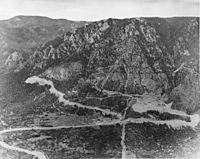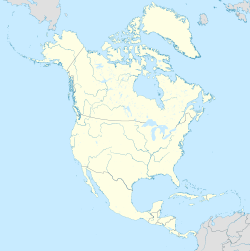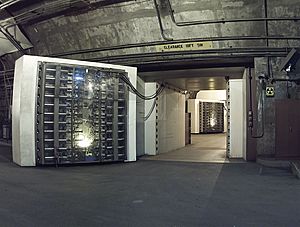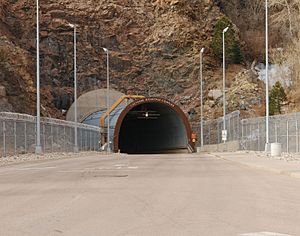Cheyenne Mountain Complex facts for kids
The Cheyenne Mountain Complex is a super-strong military base built deep inside Cheyenne Mountain in Colorado, near Colorado Springs. It's like a secret underground city! This special place is part of the United States Space Force and was designed to protect important military commands.
In the past, the Complex was the main control center for the North American Aerospace Defense Command (NORAD) and the United States Space Command. It watched the skies over Canada and the United States for missiles, space objects, and enemy aircraft using a worldwide early-warning system. Since 2008, NORAD's main headquarters moved to Peterson Space Force Base nearby. Now, the Cheyenne Mountain Complex is mostly used for training military crews and as a backup command center, ready to take over if needed.
Many different military groups have used this complex over the years, including parts of NORAD, U.S. Space Command, and others. It even has a communication center used by the U.S. Civil Defense Warning Center.
Quick facts for kids Cheyenne Mountain Complex |
|
|---|---|
| Part of Cheyenne Mountain Space Force Station | |
| unincorporated El Paso County, Colorado | |
 |
|
| Coordinates | 38°44′33″N 104°50′54″W / 38.74250°N 104.84833°W |
| Site information | |
| Operator | United States Space Force |
| Controlled by | Peterson-Schriever Garrison |
| Site history | |
| Built | May 18, 1961 – February 8, 1966 |
| In use |
|
Contents
Facilities
Main Chambers
This amazing complex is built under 2,000 feet (610 m) of solid granite rock! It covers an area of about 5 acres (2 hectares). Inside, there are fifteen three-story buildings. These buildings aren't just sitting on the ground; they are protected by a special system of giant springs. Imagine buildings floating on springs! This system helps them stay safe and operational even during an earthquake or an explosion. More than 1,000 springs are used to keep the buildings from moving more than an inch.
The complex is also designed to withstand an electromagnetic pulse (EMP), which is a burst of energy that can damage electronics. It's the only military facility at a high altitude that can do this. Inside, there are many beds for personnel, including special suites for high-ranking officers. It's like a small town with a medical facility, a store, a cafeteria, and even fitness centers both inside and outside the mountain.
Blast Doors
The bunker is built to survive a huge nuclear explosion as close as 2 kilometers (1.2 miles). Inside the mountain tunnels, there are sets of giant blast doors, each weighing 25 tons! These doors are designed to withstand a powerful blast wave and can always be opened when needed. The complex also has special filters to protect against airborne chemical, biological, radiological, and nuclear dangers.
Outdoor Facilities
Outside the main military complex, you'll find parking lots, a fire station, and places for fun and relaxation. These include Mountain Man Park, picnic areas, a racquetball court, a softball field, a sand volleyball court, a basketball court, a putting green, and a horseshoe area.
Support Area
The Cheyenne Mountain Complex is self-sufficient. It has its own power plant, heating and cooling systems, and a water supply. The team that manages the base makes sure that its electricity, water, air conditioning, and other systems are incredibly reliable, working 99.999% of the time!
The base is prepared for many different situations, from medical emergencies and natural disasters to various types of attacks. The least likely events, like a general nuclear attack, are also the most dangerous, and the complex is built to handle them.
More water comes from the mountain springs than the base actually needs. There's a huge reservoir that holds 1.5 million US gallons (5,700 m³) of water, ensuring enough supply even for fighting fires. Another massive reservoir of 4.5 million US gallons (17,000 m³) is used to help cool the facility. The complex also has a large supply of diesel fuel and a huge bank of batteries with backup power generators.
History
Building the Complex
The idea for the Cheyenne Mountain Complex came about in the late 1950s during the Cold War. Military leaders wanted a super-strong command center to protect against long-range Soviet bombers, missiles, and nuclear attacks.
Construction began on May 18, 1961. The United States Army Corps of Engineers oversaw the excavation of Cheyenne Mountain. It took years of hard work to dig out the tunnels and chambers inside the mountain.
The main operations centers inside the complex became fully ready for use on February 6, 1967. The entire project cost about $142.4 million back then. The complex had advanced electronic and communication systems that could quickly analyze aerospace data. By 1967, the National Civil Defense Warning Center was also located inside the bunker.
Operations and Upgrades
Over the years, the Cheyenne Mountain Complex was constantly updated to keep up with new technology and threats.
- Early Systems: In the 1970s, systems were improved to process satellite information and track objects in space.
- Missile Defense: A system called the Ballistic Missile Defense Center was installed in 1974 to help warn about missile attacks.
- Command Center: By 1978, the NORAD Combat Operations Center housed five different operating centers and a command post. These included centers for tracking space objects, analyzing intelligence, monitoring weather, and supporting the NORAD Commander.
- Space Defense: The Space Defense Operations Center (SPADOC) was created in 1979 to bring together space surveillance and other space-related operations.
- Major Upgrades: The Cheyenne Mountain Complex Improvements Program (427M) was a big upgrade in 1979. It aimed to modernize the command center, space, and missile functions with new software and powerful computers. However, it had some early problems.
- False Alarms: In 1979 and 1980, there were a few times when the systems gave false missile warnings. This was a serious issue, and engineers worked hard to fix the problems, including replacing faulty computer chips and improving how staff responded to warnings. A special testing facility was set up to test changes offline before they were put into action.
- Continued Improvements: Throughout the 1980s and 1990s, more systems were added or upgraded, like the Joint Surveillance System (JSS) and the Survivable Communications Integration System (SCIS) for communicating warning messages.
- Modernization: By the early 2000s, a major program called CCIC2S began to upgrade all the mission systems inside Cheyenne Mountain, including space surveillance.
By 2003, consoles for the Ground-Based Mid-Course Defense (GMD), which helps defend against missiles, were added.
Moving Operations
In 2006, NORAD decided to move many of its main operations to Peterson Air Force Base nearby. This meant that the Cheyenne Mountain Complex would no longer be staffed 24/7. Instead, it would be kept on "warm standby," meaning it's ready to go but only staffed when needed for training or as a backup.
On May 12, 2008, the command center inside Cheyenne Mountain was officially renamed the NORAD and USNORTHCOM Alternate Command Center.
NORAD Alternate Command
Since 2002, the complex has been known as Cheyenne Mountain Air Force Station. It's mainly used for training crews and as the backup command center for NORAD and USNORTHCOM. The 21st Mission Support Group keeps the complex running smoothly.
Today, NORAD and USNORTHCOM use less than 30% of the space inside the complex and make up about 5% of the people there daily. Most day-to-day operations happen at Peterson Air Force Base.
Protecting Communications
In 2015, military leaders announced a big project to move more communication systems into the Cheyenne Mountain Complex. This was done to protect them from an electromagnetic pulse (EMP) attack, because the complex is specially built to withstand such events.
Units
Many different military units have been based at or supported the Cheyenne Mountain Complex over the years. These include groups focused on managing the complex, air defense, space surveillance, intelligence, and civil engineering. For example, the 1st Space Control Squadron, which tracks objects in space, has been located here.
In Popular Culture
Movies
- WarGames (1983): This movie is partly set at a command center called Crystal Palace, which was inspired by the Cheyenne Mountain Complex.
Television
- Stargate SG-1: In this popular science fiction show, the secret Stargate Command is located inside Cheyenne Mountain. In real life, there's even a broom closet in the actual complex called "Stargate Command" as a nod to the show!
- Jeremiah: The bunker is also a setting in this TV series.
Video Games
- Horizon: Zero Dawn: In this game, Cheyenne Mountain is known as All-Mother Mountain. The Complex was turned into a special facility before the end of the world, and the main character, Aloy, was found inside it.
|








